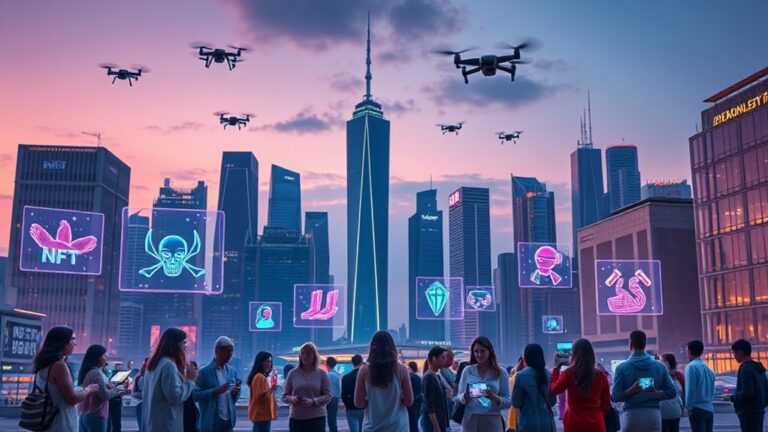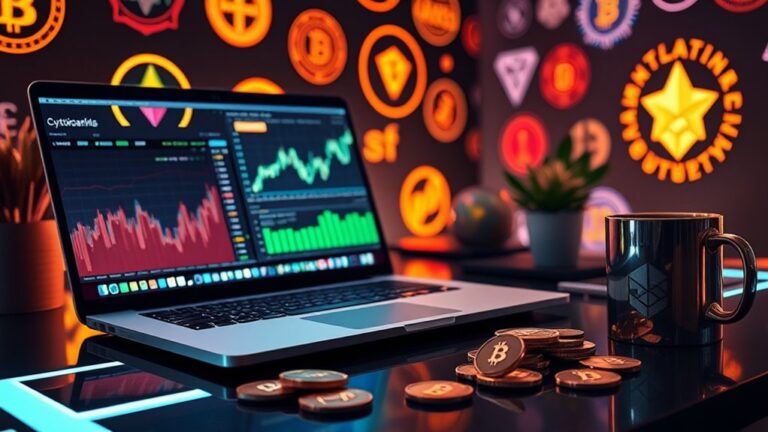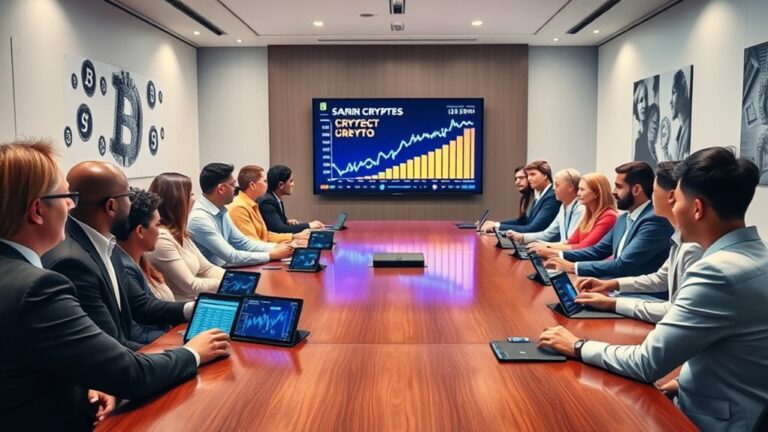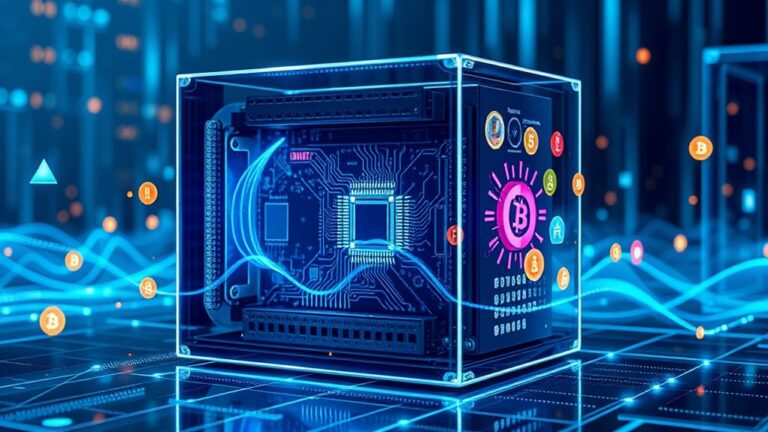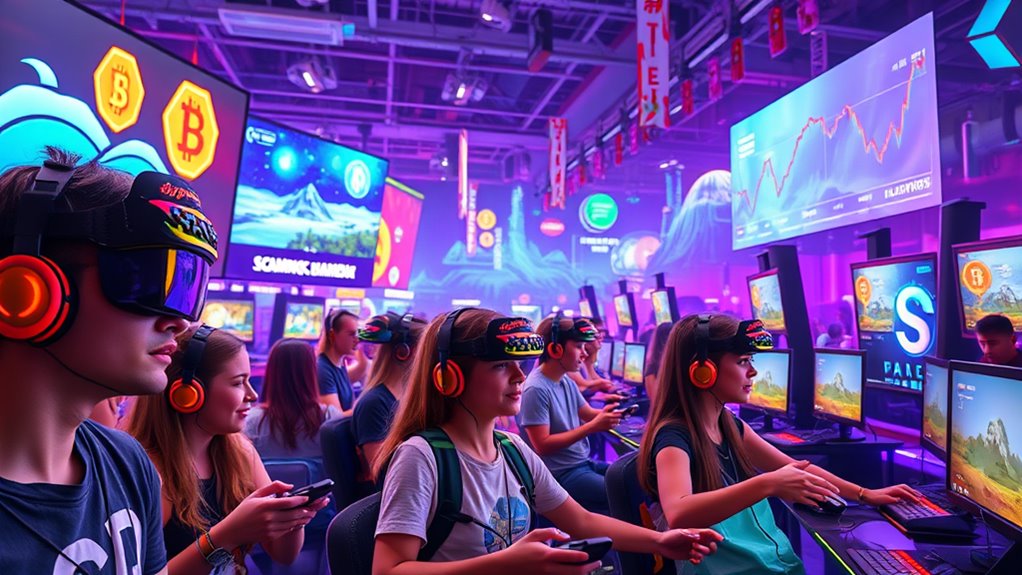
Crypto in Gaming and Metaverse Growth: Top Trends Driving Adoption
The growth of cryptocurrency in gaming and the metaverse is driven by several key trends. Blockchain integration enhances security and transparency, allowing players to verify ownership of digital assets. The rise of play-to-earn models rewards players with real-world value through in-game activities. Additionally, NFT marketplaces enable the buying and selling of unique digital assets, while decentralized governance allows players to influence game design. These developments foster community engagement and investment, leading to new opportunities in the digital landscape. More insights await.
Key Takeaways
- The blockchain gaming market is expected to grow significantly, from USD 14.8 billion in 2024 to USD 1,172.8 billion by 2033, indicating strong adoption.
- Play-to-Earn models empower players by allowing them to earn real-world value through in-game activities, fostering community engagement.
- NFT marketplaces enhance ownership opportunities, enabling players to buy, sell, and trade digital assets securely and transparently.
- Community-driven platforms facilitate user participation in asset creation and governance, increasing investment and engagement within the gaming ecosystem.
- Future trends include AI-powered experiences and cross-platform interoperability, enhancing gameplay and expanding economic opportunities for players and developers.
Blockchain Integration in Gaming
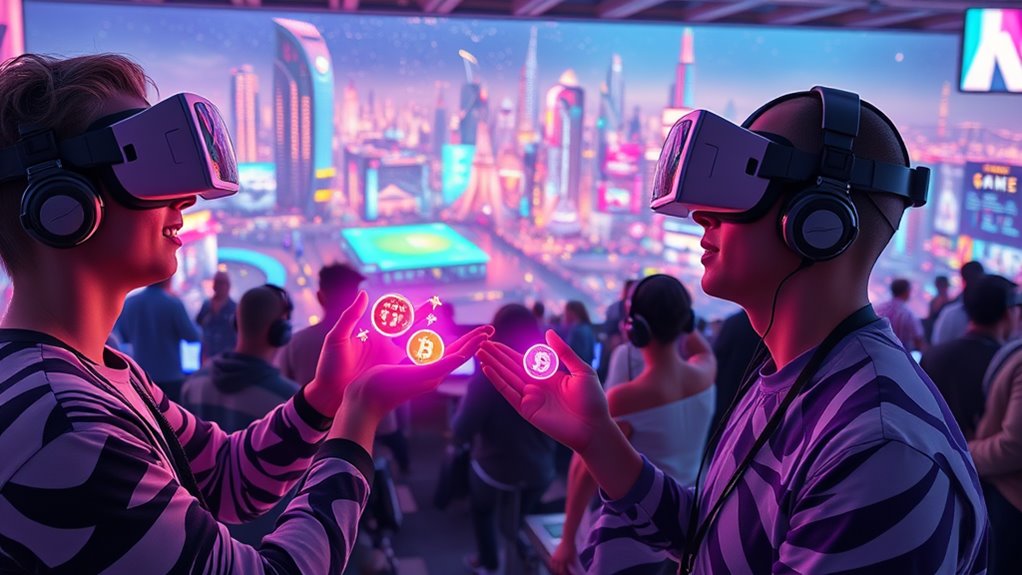
Blockchain integration in gaming represents a significant shift in how digital ownership and virtual economies function. This technology has allowed the blockchain gaming market to grow from USD 14.8 billion in 2024 to an anticipated USD 1,172.8 billion by 2033, reflecting a compound annual growth rate of 62.59%.
One of the key innovations is the use of non-fungible tokens (NFTs), which enable players to own, buy, sell, and trade in-game items securely. This model fosters player engagement and loyalty by providing real stakes in virtual environments.
The Asia-Pacific region leads this market due to its vibrant gaming culture and technological advancements. Overall, blockchain not only guarantees tamper-proof ownership but also enhances the trading and value of digital assets in gaming. Additionally, the integration of cryptocurrencies for secure transactions is pivotal in establishing trust and facilitating seamless exchanges within these virtual economies.
Rise of Play-to-Earn Models
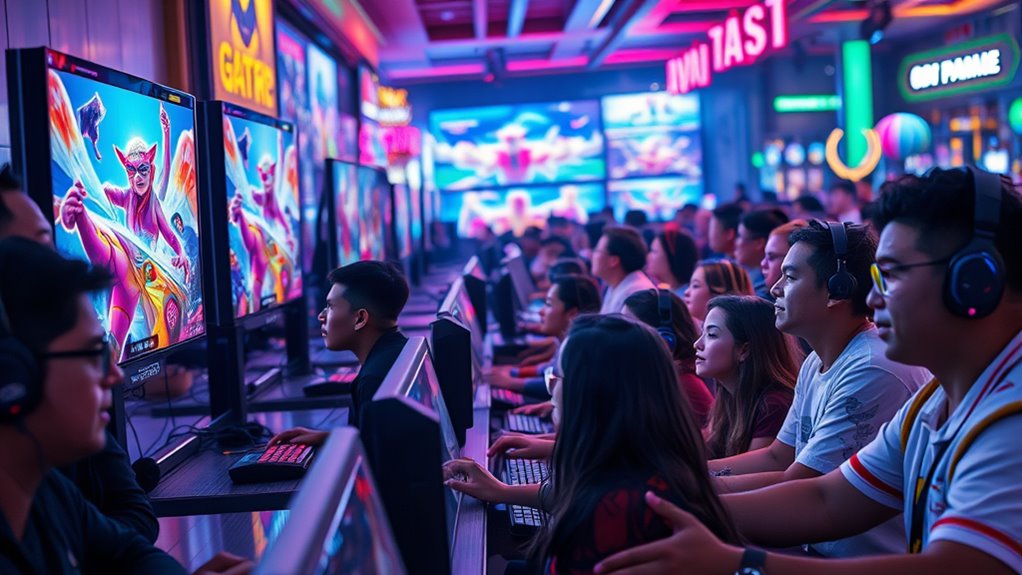
The rise of Play-to-Earn (P2E) models has transformed the gaming landscape by providing players with the opportunity to earn real-world value through their in-game activities.
The emergence of Play-to-Earn models revolutionizes gaming, enabling players to gain real-world value from their in-game efforts.
P2E games reward players with cryptocurrencies and NFTs, which can be traded for actual money. This market, valued at $755 million in 2021, is projected to grow to $6.30 billion by 2031, indicating an annual growth rate of 21.3%.
Assets earned in these games are secured using blockchain technology, giving players true ownership. Additionally, P2E models enhance community engagement, as players collaborate towards common goals.
While challenges such as market fluctuations and entry barriers exist, the overall trend reflects a significant shift in how gaming is perceived, blending entertainment with economic opportunity.
The Emergence of NFT Marketplaces
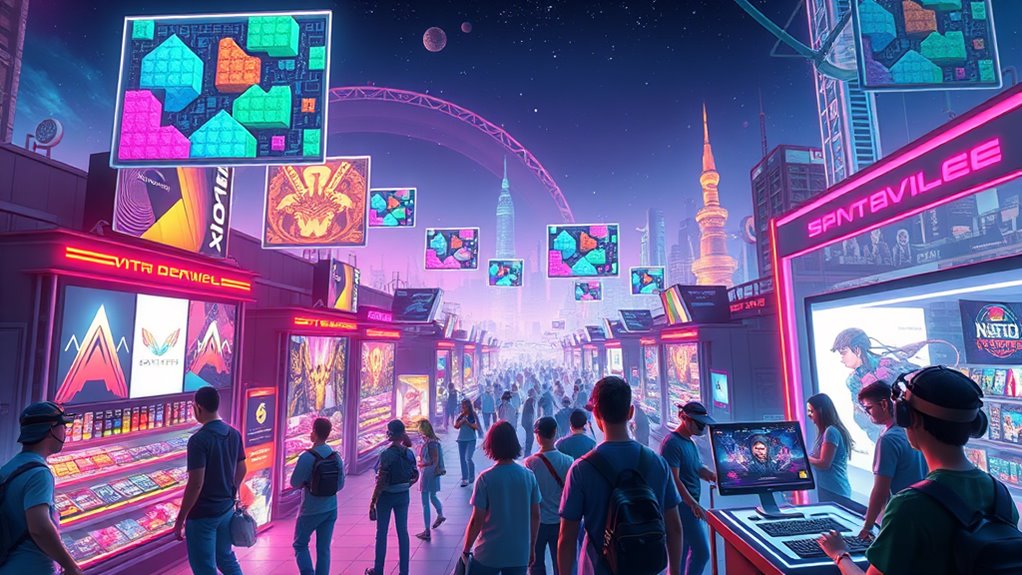
In recent years, a notable rise in NFT marketplaces has transformed how digital assets are bought, sold, and traded within the metaverse.
These platforms integrate e-commerce and blockchain technology, enabling users to engage in immersive shopping experiences. By allowing decentralized trading of NFTs, they promote transparency and security, which are essential for user trust.
In the gaming industry, NFT marketplaces empower players to monetize their in-game assets, enhancing overall engagement. Additionally, virtual real estate can be exchanged as NFTs on platforms like Decentraland. The versatility of NFTs extends beyond gaming and art, with applications in digital identity management, leading to increased adoption and potential applications in charity and social impact initiatives.
Decentralized Governance in Game Development
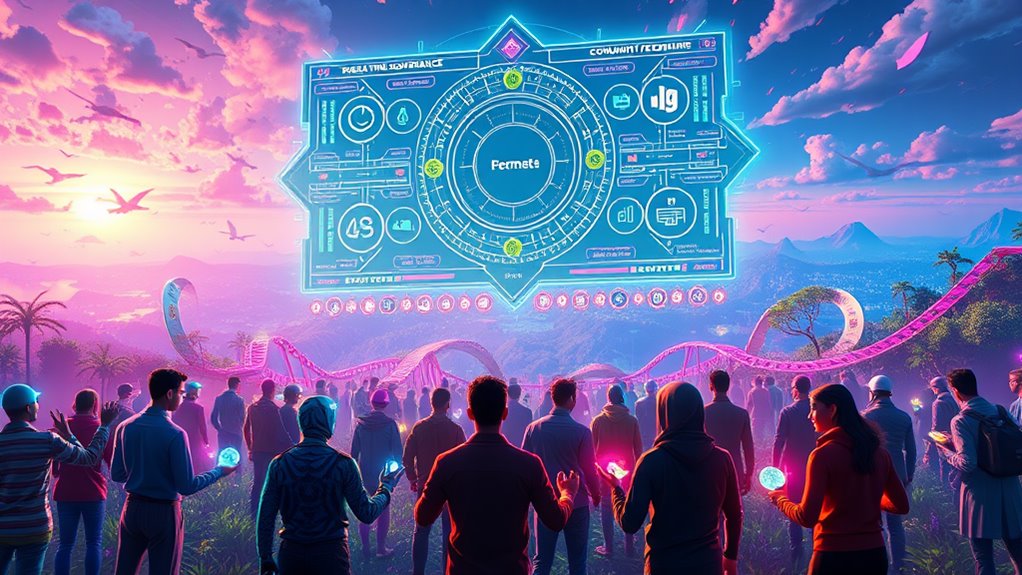
Decentralized governance represents a significant evolution in game development, building upon the foundation established by NFT marketplaces that have reshaped digital ownership.
This model utilizes Decentralized Autonomous Organizations (DAOs), where community members can participate in decision-making through token-based voting. Players influence game mechanics, content updates, and monetization strategies, fostering a collaborative environment.
Smart contracts automate the governance process, ensuring fairness and transparency. However, challenges remain, such as regulatory uncertainties and potential governance disputes.
Despite these hurdles, decentralized governance enhances player engagement and ownership, creating a sense of investment in the game. This shift from traditional centralized control allows for innovative mechanics and quicker adaptation to community feedback, ultimately shaping the evolution of gaming experiences. Additionally, as Ethereum’s transition to proof-of-stake improves efficiency, it provides a robust infrastructure for decentralized applications that can further empower game developers and players alike.
Security and Transparency Through Blockchain
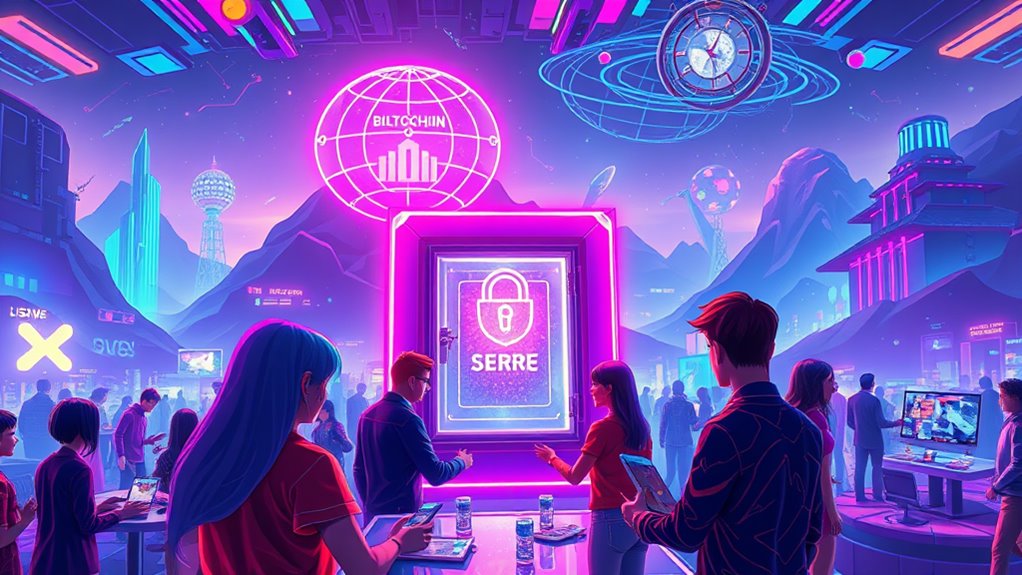
Blockchain technology plays an essential role in enhancing security and transparency within the gaming and metaverse environments. By utilizing decentralized systems, blockchain guarantees that digital assets are both secure and verifiable.
Blockchain technology enhances security and transparency in gaming and the metaverse, ensuring secure and verifiable digital assets.
Key advantages include:
- Secure Asset Ownership: Blockchain acts as a tamper-proof ledger, confirming true ownership through non-fungible tokens (NFTs).
- Enhanced Security Measures: Smart contracts, when audited, manage transactions safely, while multi-factor authentication adds protection against unauthorized access.
- Interoperability: Blockchain enables digital assets to be used across different platforms, promoting a unified gaming experience.
- Transparency: Clear transaction records minimize risks of theft or manipulation, fostering trust among players.
Through these features, blockchain greatly enhances security and transparency, which are essential for the evolving landscape of gaming and the metaverse. Additionally, the use of non-fungible tokens allows for unique digital assets that can represent ownership of various in-game items and experiences.
User-Generated Content in the Metaverse
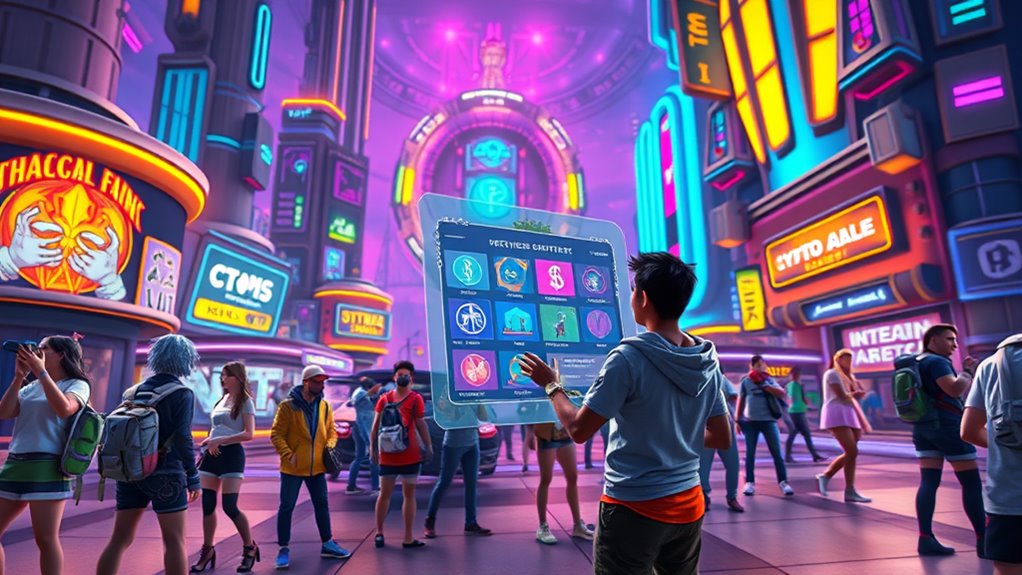
User-generated content (UGC) plays a pivotal role in shaping the metaverse, as it empowers individuals to create unique experiences and environments. UGC encompasses a variety of forms, including videos, mods, and 3D models, allowing users to customize their virtual spaces.
Platforms like Minecraft and Roblox exemplify the importance of UGC, providing tools for users to build complex worlds. This content fosters engagement and investment, as users contribute to their ecosystems, enhancing the immersive experience.
Additionally, UGC supports the decentralized ethos of Web 3.0, granting creators ownership over their work. While challenges such as scalability and monetization exist, the future of UGC in the metaverse promises innovation and economic opportunities for users through advanced technologies like blockchain and AI.
Community Building for Sustainable Growth
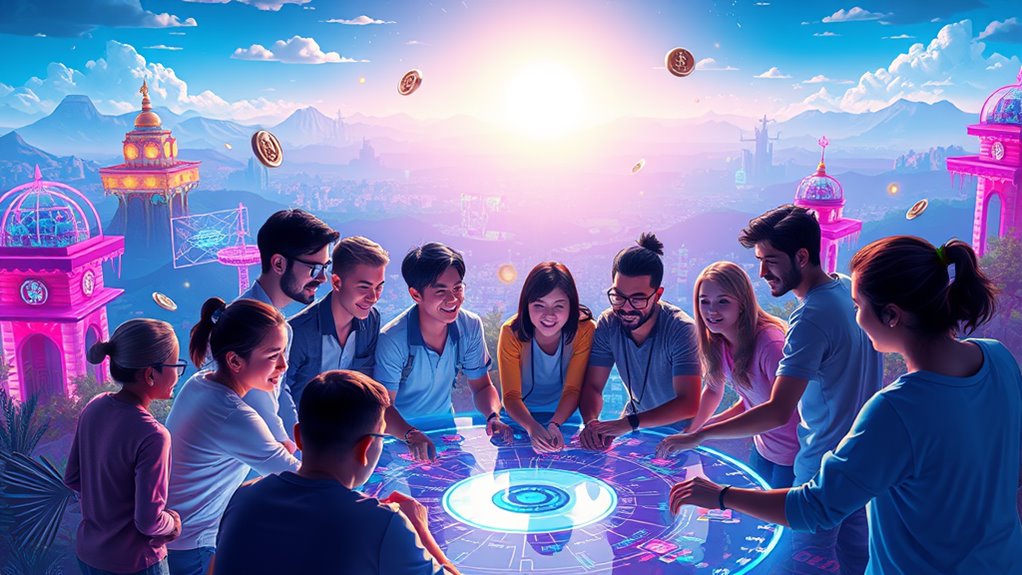
In the metaverse, community building is often essential for sustainable growth, as it fosters a sense of belonging among players. Effective community engagement draws individuals together and enhances their gaming experience through various strategies:
- Multidisciplinary Focus: Combines gaming, social interaction, and digital economies to engage users.
- Collaborative Gameplay: Encourages teamwork through quests, tournaments, and social activities, strengthening community bonds.
- Virtual Events: Platforms like Roblox and Fortnite host concerts and meetups, enriching social experiences.
- Decentralized Governance: Blockchain technology allows users to participate in decision-making, promoting trust and involvement.
The Virtual Real Estate Boom
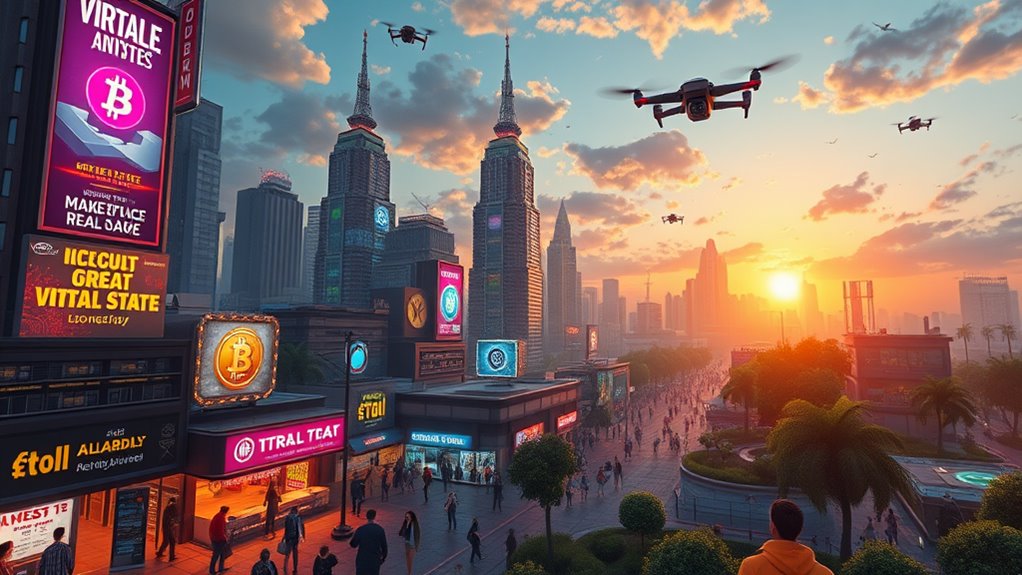
The virtual real estate boom highlights significant ownership and monetization opportunities within the metaverse.
As users create and develop assets driven by community input, the potential for diverse applications in virtual spaces expands.
This evolving landscape presents both creative possibilities and economic prospects, raising interest among investors and creators alike.
Ownership and Monetization Opportunities
A notable trend in the metaverse is the rise of virtual real estate, which presents unique ownership and monetization opportunities for investors and businesses alike. This digital property, confirmed through NFTs, allows users to engage in various activities in immersive environments.
Key factors driving interest in virtual land include:
- Popularity and Foot Traffic: Virtual properties in high-traffic areas tend to appreciate in value.
- Platform Reputation: The credibility of the metaverse platform can markedly influence land prices.
- Development Options: Opportunities for development and leasing enhance income potential.
- Advertising and Events: Virtual real estate can serve as a venue for marketing and entertainment, creating additional revenue streams.
The landscape of virtual real estate continues to evolve, attracting attention from various sectors.
Community-Driven Asset Creation
Community-driven asset creation has emerged as a significant force in the metaverse, particularly in the domain of virtual real estate. Platforms like Decentraland and The Sandbox empower users to purchase, develop, and monetize virtual land using cryptocurrencies.
These platforms utilize non-fungible tokens (NFTs) to represent unique digital assets, ensuring secure transactions and ownership verification through blockchain technology. User-generated content tools enable creators to design custom assets, enhancing the overall gaming experience.
Additionally, marketplaces such as OpenSea facilitate the buying and selling of these digital assets, further driving engagement. As community involvement increases, new trends like fractional ownership and community governance are emerging, presenting additional opportunities for users to participate in and benefit from the virtual real estate market.
Future Trends in Crypto Gaming and Metaverse
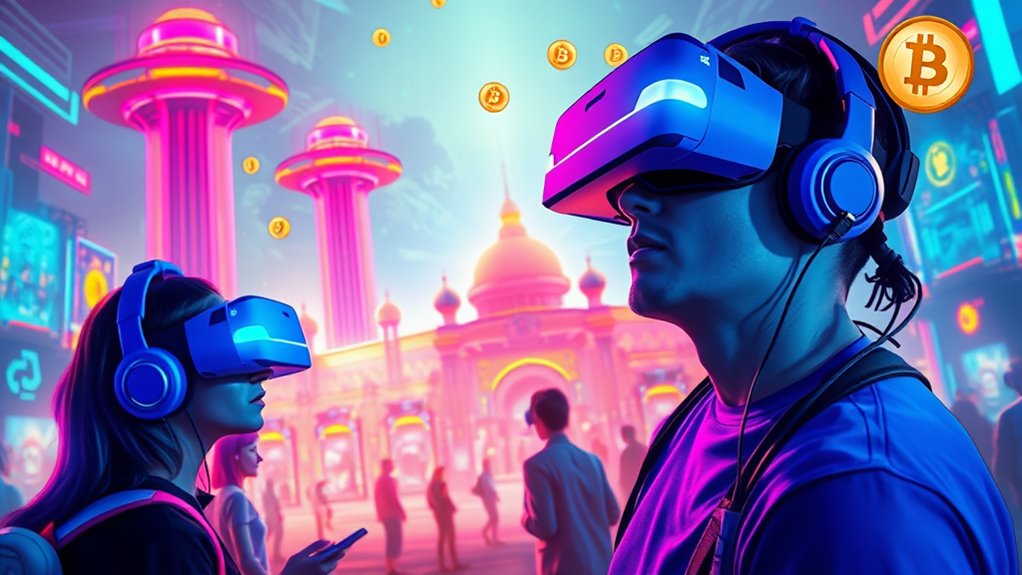
The future of crypto gaming and the metaverse is likely to see significant advancements through AI-powered game experiences and cross-platform asset interoperability.
AI technology can enhance gameplay by creating personalized experiences and dynamic environments, making gaming more engaging for players.
Additionally, enabling the transfer of digital assets across different platforms will foster a more interconnected gaming ecosystem, allowing players to utilize their assets seamlessly across various games and virtual worlds.
AI-Powered Game Experiences
Integrating artificial intelligence into gaming is transforming player experiences within the crypto gaming and metaverse landscape.
AI enhances gameplay by creating more interactive, personalized, and engaging environments. This evolution leads to several key benefits:
- Procedural Generation: AI generates vast and unique game worlds, offering players diverse experiences.
- AI-Driven Characters: Non-player characters (NPCs) react intelligently to player actions, deepening engagement.
- Personalized Gameplay: AI analyzes player behavior to customize experiences, making games more appealing.
- Dynamic Environments: Environments evolve based on players’ actions, enhancing immersion.
The integration of AI not only enriches gameplay but also fosters a deeper connection between players and the gaming world, signaling a promising future for crypto gaming and the metaverse.
Cross-Platform Asset Interoperability
As the gaming industry evolves, cross-platform asset interoperability is becoming increasingly important, enabling players to use in-game assets across different games and platforms.
This interoperability allows for seamless asset transfers, enhancing player experiences and increasing the value of digital items.
Blockchain technology plays an essential role, utilizing standardized formats for non-fungible tokens (NFTs) like ERC-721 and ERC-1155, which facilitate recognition across various platforms.
Despite challenges such as standardization and scalability, solutions like smart contracts and cross-chain protocols are being developed to guarantee secure transactions.
Ultimately, interoperability fosters community building, enhances gameplay, and opens new economic opportunities for both players and developers, paving the way for a more interconnected gaming ecosystem in the metaverse.
Frequently Asked Questions
How Do Blockchain Games Ensure Fairness and Prevent Cheating?
Blockchain games guarantee fairness and prevent cheating through provably fair mechanisms, immutable records, and transparent gameplay. Players verify outcomes using cryptographic hashes, while decentralized systems protect data and automate rules, fostering trust within the gaming community.
What Are the Risks of Investing in Virtual Real Estate?
Investing in virtual real estate is akin to steering through a minefield; risks include platform control, regulatory uncertainty, market volatility, technological challenges, and security threats, all of which can jeopardize the stability and value of investments.
How Do I Start Earning Through Play-To-Earn Games?
To start earning through play-to-earn games, individuals should choose a game that suits their interests, create an account, engage in gameplay to earn rewards, and explore opportunities for trading or staking in-game assets.
What Cryptocurrencies Are Best for In-Game Purchases?
The best cryptocurrencies for in-game purchases include The Sandbox (SAND) and Decentraland (MANA) for virtual assets, Axie Infinity (AXS) for NFT gameplay, and Gala (GALA) for engaging play-to-earn models. Each offers unique benefits.
How Can I Protect My NFTS From Theft?
To protect NFTs from theft, one should use hardware wallets, enable two-factor authentication, regularly update software, secure seed phrases, monitor transactions, and remain vigilant against phishing attempts and suspicious links.
Conclusion
To sum up, the integration of cryptocurrency in gaming and the metaverse is reshaping digital experiences. With trends such as play-to-earn models and NFT marketplaces paving the way, players are finding new ways to engage and invest. As users navigate this evolving landscape, characterized by decentralized governance and community-driven growth, the future promises innovative opportunities. Just as the printing press revolutionized information dissemination centuries ago, blockchain technology is poised to redefine how virtual worlds operate and thrive.

